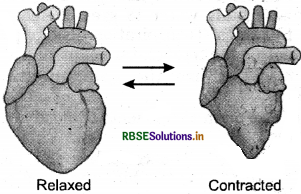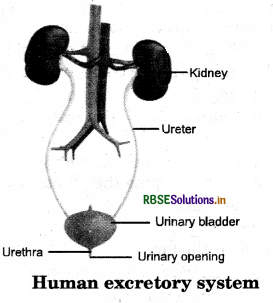RBSE Solutions for Class 7 Science Chapter 11 Transportation in Animals and Plants
Rajasthan Board RBSE Solutions for Class 7 Science Chapter 11 Transportation in Animals and Plants Textbook Exercise Questions and Answers.
Rajasthan Board RBSE Solutions for Class 7 Science in Hindi Medium & English Medium are part of RBSE Solutions for Class 7. Students can also read RBSE Class 7 Science Important Questions for exam preparation. Students can also go through RBSE Class 7 Science Notes to understand and remember the concepts easily. The class 7 science chapter 4 heat extra questions are curated with the aim of boosting confidence among students.
RBSE Class 7 Science Solutions Chapter 11 Transportation in Animals and Plants
RBSE Class 7 Science Transportation in Animals and Plants InText Questions and Answers
Page 121
Question 1.
Why is the colour of blood red?
Answer:
Due to the presence of iron pigment called haemoglobin in the blood.

Page 123
Question 2.
I am confused! I have learnt that an artery always carries oxygen - rich blood.
Answer:
Pulmonary artery carry carbon dioxide rich blood from the heart to the lungs whereas arteries carry oxygen rich blood from the heart to the all body parts. Both are different. Similarly pulmonary veins carry oxygen rich blood from lungs to the heart whereas veins carry carbon dioxide rich blood from all parts of body to the heart.
Page 124
Question 3.
Paheli wonders which side of the heart will have oxygen - rich blood and which side will have carbon dioxide - rich blood.
Answer:
Left side of the heart have oxygen - rich blood and right side of heart will have carbon dioxide - rich blood.
Page 127
Question 4.
Paheli wants to know whether other animals alsourinate.
Answer:
The mammals (animals likedpgs, cow, cat, sheep, horse, etc. that have mammary glands) also urinate.
Page 128
Question 5.
Boojho thinks that plants may have pipes to transport water to the entire plant like we have in our homes for the supply of water.
Answer:
Yes, plants have pipe - like vessels to transport water and nutrients from roots to the leaves. Roots absorb water and nutrients from soil and transport to the all parts of plants through vessels. These vessels are made of special cells and form vascular tissues. These vascular tissues transport water and nutrients in the plants and it is called xyleip.
Page 129
Question 6.
Paheli says her mother puts ladyfinger and other vegetables in water if they are somewhat dry. She wants to know how water enters into them?
Answer:
Ladyfinger and other vegetables are put into water to moisture them through the process of osmosis. Osmosis is the movement of water molecule from an area of higher concentration to the lower concentration through semi-permeable membrane.
Question 7.
Boojho wants to know why plants absorb a large quantity of water from the soil, then give it off by transpiration.
Answer:
Plants need water for photosynthesis which is absorbed through roots. Transpiration provides a suction pull which helps in water absorption. In order to keep the continuous flow of water in upward direction, the plants need to lose its water from its leaves. Also transpiration helps in regulating the temperature of plants by the evaporation of water from leaves.
RBSE Class 7 Science Transportation in Animals and Plants Textbook Questions and Answers
Question 1.
Match structures given in Column I with functions given in Column II:
|
Column I |
Column II |
|
(i) Stomata |
(a) Absorption of water |
|
(ii) Xylem |
(b) Transpiration |
|
(iii) Root hairs |
(c) Transport of food |
|
(iv) Phloem |
(d) Transport of water |
|
|
(e) Synthesis of carbohydrates |
Answer:
|
Column I |
Column II |
|
(i) Stomata |
(b) Transpiration |
|
(ii) Xylem |
(d) Transport of water |
|
(iii) Root hairs |
(a) Absorption of water |
|
(iv) Phloem |
(c) Transport of food |
Question 2.
Fill in the blanks
(i) The blood from the heart is transported to all parts of the body by the ..............................
(ii) Haemoglobin is present in .............................. cells.
(iii) Arteries and veins are joined by a network of ..............................
(iv) The rhythmic expansion and contraction of the heart is called ..............................
(v) The main excretory product in human being is ..............................
(vi) Sweat contains water and ..............................
(vii) Kidneys eliminate the waste materials in the liquid form called ..............................
(viii) Water reaches great heights in the trees because of suction pull caused by ..............................
Answer:
(i) arteries
(ii) red blood
(iii) capillaries
(iv) heartbeat
(v) urea
(vi) salt
(vii) mine
(viii) transpiration.
Question 3.
Choose the correct option
(a) In plants, water is transported through:
(i) xylem
(ii) phloem
(iii) stomata
(iv) root hair
Answer:
(i) xylem.
(b) Water absorption through roots can be increased by keeping the plants:
(i) in the shade
(ii) in dim light
(iii) under the fan
(iv) covered with a polythene bag
Answer:
(iii) under the fan.
Question 4.
Why is transport of materials necessary in a plant or in an animal? Explain.
Answer:
Transport of material is necessary for plants or animals because it makes nutrients and oxygen available to all parts of the body. If in any case, the transport of the necessary nutrients and oxygen do not reach all parts of the body, then the body will not be able to survive.

Question 5.
What will happen if there are no platelets in the blood?
Answer:
The blood platelets are responsible for the dotting of the blood. In case of any injury, a dark red clot is formed because of platelets. If there are less platelets, the blood will keep on flowing leading to tremendous blood loss.
Question 6.
What are stomata? Give two functions of stomata.
Answer:
The small opening on the lower surface of the leaves are called stomata. These openings are surrounded by guard cells.
Functions of stomata are as follows:
(a) It helps in the transpiration of water i. e., to remove the excess of water through leaves. Loss of water generates a suction pull which helps in absorption of water from the roots.
(b) It helps in gaseous exchange.
Question 7.
Does transpiration serve any useful function in the plants? Explain.
Answer:
The process of removal of excess water through leaves of plants is called transpiration. The evaporation of water from leaves generates a suction pull which not only helps in the absorption of water, but also pulls water to great heights in the tall trees. Transpiration also helps in regulating the temperature of plant.
Question 8.
What are the components of blood?
Answer:
The main components of blood are as follows:
- Plasma: The colourless fluid part of the blood, in which the blood cells float.
- Red blood cells: RBCs are spherical cells devoid of a nucleus. They contain red pigment called haemoglobin that binds with oxygen to form oxyhaemo - globin to supply oxygen to the blood tissues.
- White blood cells: WBCs are colourless cells, fewer in number and larger than RBCs. They protect the body against diseases.
- Platelets: Platelets are the smallest cells in the body. Their main function is to help in blood clotting.
Question 9.
Why is blood needed by all the parts of a body?
Answer:
Blood is needed by all the parts of the body because it regulates the proper functioning of all the body parts.
Blood helps in:
- Transportation of substances like digested food from the small intestine to the other parts of the body.
- Carrying oxygen from the lungs to the cells of the body.
- Transportation of wastes for removal from the body.
Question 10.
What makes the blood look red?
Answer:
Blood looks red because of the presence of iron pigment called haemoglobin. Haemoglobin binds with the oxygen and transport it to all the parts of the body.
Question 11.
Describe the function of the heart.
Answer:
Heat is a muscular organ that pumps blood through the network of arteries and veins called the cardiovascular system. It supplies oxygen and nutrients to the tissues and removes carbon dioxide and other wastes.

Diastole and systole are two phases of the cardiac cycle. They occur as heartbeats. Systole occurs when the heart contracts to pump blood out and diastole occurs when the heart relaxes after contraction. Function during contraction and relaxation of heart:
• The right atrium receives blood from the veins and pumps it to the right ventricle.
• The right ventricle receives blood from the right atrium and pumps it to the lungs it is loaded with oxygen.
• The left artium receives oxygenated blood from the lungs and pumps it to the left ventricle.
• The left ventricle (strongest chamber) pumps oxygen - rich blood to the rest of the body.
Question 12.
Why is it necessary to excrete waste products?
Answer:
It is necessary to excrete waste products because they are toxic. If these toxic materials are not removed from the body, they get mixed with the blood and can damage the cells of the body.

Question 13.
Draw a diagram of the human excretory system and label the various parts.
Answer:


- RBSE Class 7 Science Notes in Hindi & English Medium Pdf Download
- RBSE Class 7 Science Important Questions in Hindi Medium & English Medium
- RBSE Solutions for Class 7 Science in Hindi Medium & English Medium
- RBSE Class 7 Science Important Questions Chapter 1 Nutrition in Plants
- RBSE Class 7 Science Notes Chapter 1 Nutrition in Plants
- RBSE Class 7 Science Important Questions Chapter 14 Electric Current and its Effects
- RBSE Class 7 Science Important Questions Chapter 13 Motion and Time
- RBSE Class 7 Science Important Questions Chapter 2 Nutrition in Animals
- RBSE Class 6 Science Notes Chapter 8 शरीर में गति
- RBSE Class 7 Science Notes Chapter 18 Wastewater Story
- RBSE Class 7 Science Notes Chapter 17 Forests: Our Lifeline